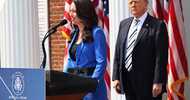
Guyana's Agriculture Minister, Noel Holder (fifth right), with officials and farmers in Brazil on a visit in 2015.
Is Guyana ready for mega-farms and genetically modified seeds?
By Laura George, Wazir Mohamed, Marcello Mello, and Medino Abraham
On June 11, 2018 Guyana’s Ministry of Agriculture (MOA) unveiled a memorandum of understanding with the Brazilian Agricultural Machinery and Research Institute to establish an agricultural village in the Rupununi savannahs. Within this arrangement, Brazilian investors who had lobbied since 2009 for access to large tracts of lands in the Rupununi savannahs were given the proverbial green light by the MOA. In 2009 some of these Brazilian investors were actually rejected by Guyana in the face of public outcry. What do we know about these investors? Research has shown that one of them, namely Yucatan Reis, was listed among others in the infamous Panama Papers for allegedly being involved in money laundering activities. Yet the most unnerving aspect of this arrangement is not the probable connections between investors and money laundering, it is the fact that the Brazilian collective, in concert with the MOA, could be tacitly promoting GMO’s as being good for the land, for indigenous communities, and for agricultural development in Guyana.
If this is true, the MOA could be taking a leap in the dark by entering into this agreement. If Guyana opens space for soya, corn, and rice mega-farms in the upcoming years, the agriculture sector will eventually or more than likely be controlled by Brazilian investors coming from a context in which the approach has been to promote genetically modified crops which destroy the land, contaminate the environment, destroy forests, and destabilize indigenous livelihoods. Global trends associated with the establishment of mega-farms has clearly shown a correlation between unsound environmental practices and recent land transfers (land grabbing) in Africa, Asia, and Latin America for production of GMO Soy, Corn, and other grains. Guyana can avoid the pitfalls of many African, Asian and Latin American countries, where foreign and local big money people are taking over land, and displacing small farmers and rural populations.
At the outset we want to make it clear that we are anti-GMO advocates who are prepared to engage in an open discussion about this issue; at the very least this is owed to the Guyanese people by the Government of Guyana. For full disclosure, government should clear the air on the following questions: What is the scientific basis for this decision? What mechanism was utilized to engage the public on this matter? Since this project is being done in the Intermediate Savannahs, what sort of consultation was done with indigenous peoples? Finally, if consultations did occur within indigenous communities, did the MOA apply the principles of the right to Free, Prior and Informed Consent (FPIC) as established in the United Nations Declaration on the Rights of Indigenous Peoples (UNDRIP)? Articles 26 and 28 speak to rights to lands, territories and resources. They call for States to respect the customs, traditions and land tenure systems and where this has not been applied, they call for the right to redress through restitution, just, fair and equitable compensation for their lands which “have been confiscated, taken, occupied, used or damaged without their free, prior and informed consent.
We must remember that the likely environmental fallout from this type of activity can have a direct impact on the livelihood practices of indigenous peoples. Recent statements issued by the regional chairman Brian Allicock about high levels of mercury contamination in the Rupununi reiterate our call for thorough environmental impact studies to be done to establish the feasibility of such projects. Furthermore, article 14:(1)(f) of the 2006 Amerindian Act (AA) highlights that Village Councils may make rules governing, “the development and regulation of agriculture”. In addition, Article 41(e) & (g) of the 2006 AA mandates that the National Toshaos Council (NTC) can provide advice to the Ministry on matters involving, “conservation and sustainable management of village lands and natural resources”. With water being a natural resource that is heavily intertwined with indigenous livelihoods, especially among riverine communities, the question arises as to whether or not the NTC was consulted about the intention of these Brazilian investors?
Guyanese ought to be concerned about the seeming rush to engage in this sort of questionable “development.” In this light it may be necessary for the authorities to apprise the public of the debates and discussion in Cabinet and in other fora on this issue. Moreover, the public should be briefed on if such a project was brought before the National Assembly, the Regional Democratic Councils, and Neighbourhood Councils, and if not why. Furthermore, someone in authority should explain the rationale for mega farms, and how mega-farms fit into the development strategy of a Green Economy? The mega-farming model falls well outside of the governing coalition party manifesto regarding ‘large scale organic farming’.
The Government of Guyana made the correct call by establishing the land commission of inquiry, but if this is not to be a pen pushing exercise only, then it is necessary to take this process to its logical conclusion. Wouldn’t it be useful to put land giveaways for establishment of mega-farms in the savannahs on hold? All land deals should be carefully investigated and analyzed. Perhaps the mandate of the Lands Commission of Inquiry should be extended to examine all the land giveaways in the Rupununi.
One such land give-away is the Santa Fe mega farm in the Rupuunni. There should be full disclosure on the quantity of land given to Santa Fe and other such activities. The husbandry practices of farms like Santa Fe must be reviewed. The jury is still out on the extent to which fertilizer and pesticide residue emanating from the Santa Fe farm impacts the land, ground water, and the environment in the Savannahs — an area prone to floods in the rainy season. The environmental impact of farms such as Santa Fe is not a new issue. To that end, we note the early commitment of the APNU administration to follow through on such matters. As early as 2014, while in opposition, the chair of the parliamentary sectoral committee on Natural Resources, APNU’s Dr. Rupert Roopnaraine, had promised to investigate the issue of toxicity and chemical contamination of the soils and water system by Santa Fe. Was this investigation completed and is there a report? In addition, several Toshaos from nearby communities to Santa Fe have already voiced their concerns about the environmental impact experienced in the community during discussions at the NTC conference in 2017.
The issue of ground and river water contamination is important. This is why information regarding fertilizers, and chemical usage and dispersal is necessary. For instance it is true that Santa Fe uses more fertilizers than rice farmers on the coast. But while there is dispersal through drainage on the coast, Sante Fe does not drain. Instead, they rely solely on irrigation and the chemicals are more than likely dispersed downwards deep into the soil. The authorities need to ensure that effective measures are being taken to protect the ground water in the Rupununi.
Is there a plan to do continuous testing of the soil, water and air at Santa Fe and other such farms? What arrangements have been made to regulate and or curb aerial spraying of chemical and crop dusting? Has the Environmental Protection Agency (EPA) examined whether aerial spraying wafts into nearby indigenous villages? Aerial spraying of chemicals by mega-farms is not a new problem. In the late 1980s, consumers in the USA virtually closed the grape industry after labour leader and activist Cesar Chavez started a hunger strike because of the health impact on grape industry workers. Bearing these issues in mind we ask, why expose the indigenous small farming communities to such risks? Should Guyana sacrifice the health of its people for short term gains of land privateers? Is it worth it? Are there any real long term benefits for the people and country?
We know that some may argue that the project is highly recommended by some Brazilian research institutions and obviously by some elements at the local level. These Brazilian institutions and their Guyanese counterparts represent a minority of research personnel in the Global South, North America and Europe who support GMO production and foods as beneficial for the environment. Some of the leading proponents against this form of development, especially activist intellectuals such as Vandana Shiva have written volumes of research that explain the damage GMO production does to small farmers, their families, their communities, and the environment. In a recently published article, Vandana Shiva gives 5 reasons why GMO’s are a recipe for famine. She argues that multinational companies produce GMOs patent seeds – what this means in practice is that small farmers lose their rights over seed varieties. It also means that in time the soil loses its fertility which can lead to desertification, increasing the push towards monocropping.
Once the practice of monocropping is normalized in small countries this development practice is deeply intertwined with the loss of local seed varieties, thus reducing biodiversity. Finally, these companies encourage the use of terminator seed technology, a scientific practice that reduces plants’ ability to reproduce which creates a cycle of dependency among small farmers who are eventually forced to continually purchase GM seeds from designated distributers.
We are not anti-development, we are pro-responsible development. In this light we call on the Government of Guyana to conduct a thorough investigation into this matter. Private investors are primarily concerned with short term profits and pay little regard to long term environmental issues. It is our duty as responsible citizens to ensure that our beautiful Guyana is safeguarded so that our children and future generations can enjoy an environment that is toxic free.
Laura George is the Governance & Rights Coordinator for the Amerindian Peoples Association. Dr. Wazir Mohamed is an Associate Professor of Sociology at Indiana University East. Marcello Mello is Brazilian and holds a M.A. in Anthropology from the Federal University of Rio. Medino Abraham is from Santa Rosa and works in the South Rupununi. He holds an MSc. in Society and Frontier from the Federal University, Roraima, Brazil.
Laura George is the Governance & Rights Coordinator for the Amerindian Peoples Association. Dr. Wazir Mohamed is an Associate Professor of Sociology at Indiana University East. Marcello Mello is Brazilian and holds a M.A. in Anthropology from the Federal University of Rio. Medino Abraham is from Santa Rosa and works in the South Rupununi. He holds an MSc. in Society and Frontier from the Federal University, Roraima, Brazil.













